Analyzing the Ideal Worker Concept in Health Administration
VerifiedAdded on 2021/05/31
|9
|2044
|31
Essay
AI Summary
This essay delves into the concept of the ideal worker within the context of health administration. It begins by outlining the essential properties of an ideal worker, including being action-oriented, intelligent, ambitious, autonomous, possessing leadership qualities, energetic, confident, honest, detail-oriented, modest, and hardworking. The essay then explores the specific responsibilities of a health administrator, emphasizing the need for these ideal worker characteristics in managing healthcare services, overseeing staff, maintaining financial records, and mediating disputes. It highlights the importance of qualities like intelligence, leadership, confidence, and energy in this role. The essay further discusses the inclusion and exclusion criteria traditionally associated with the ideal worker, touching on gender bias and marital status preferences. Finally, it examines the implications of the ideal worker concept for the health workforce, asserting that both men and women can become effective healthcare leaders, and that commitment to work is highly personal and varies across individuals. The essay concludes by referencing relevant literature on workforce management and healthcare administration.
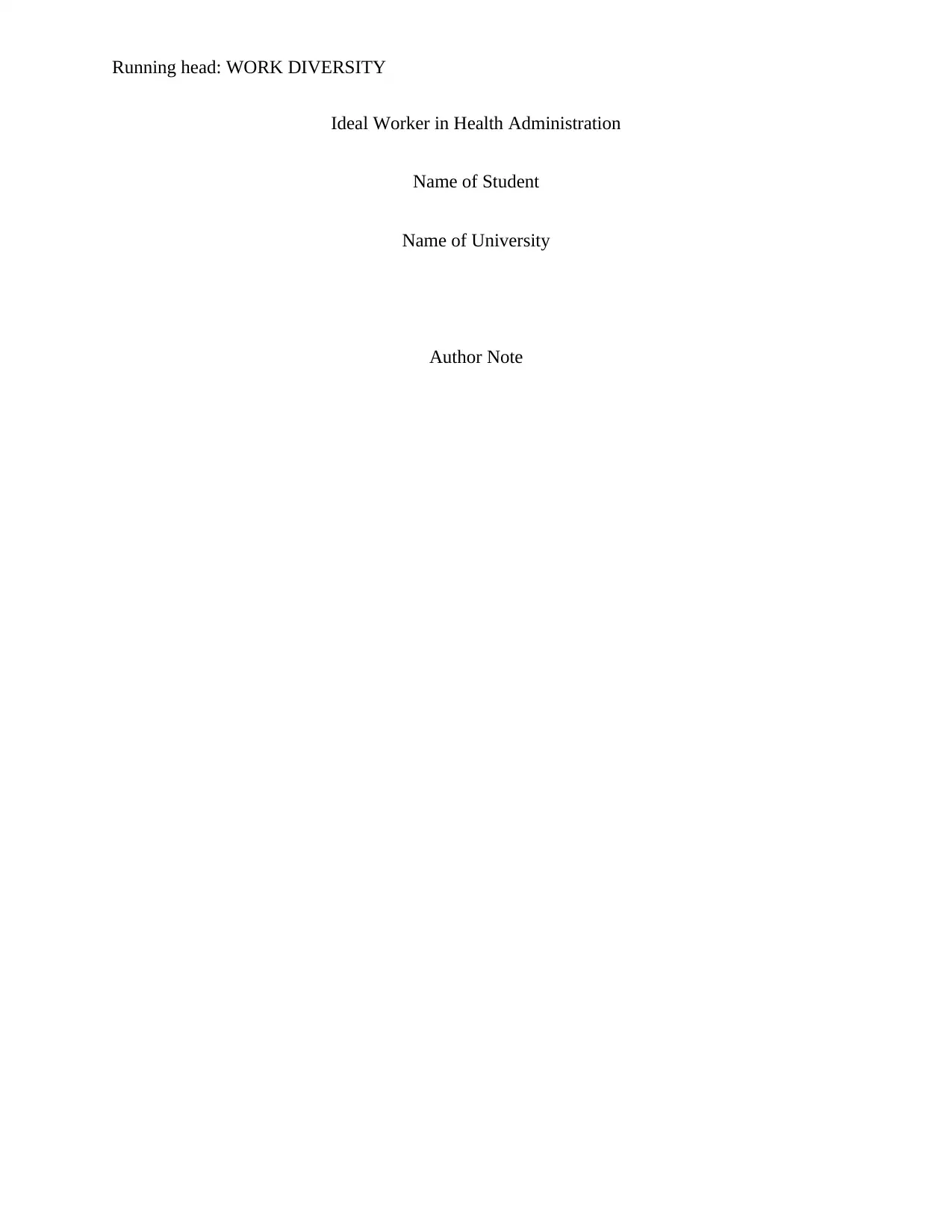
Running head: WORK DIVERSITY
Ideal Worker in Health Administration
Name of Student
Name of University
Author Note
Ideal Worker in Health Administration
Name of Student
Name of University
Author Note
Paraphrase This Document
Need a fresh take? Get an instant paraphrase of this document with our AI Paraphraser
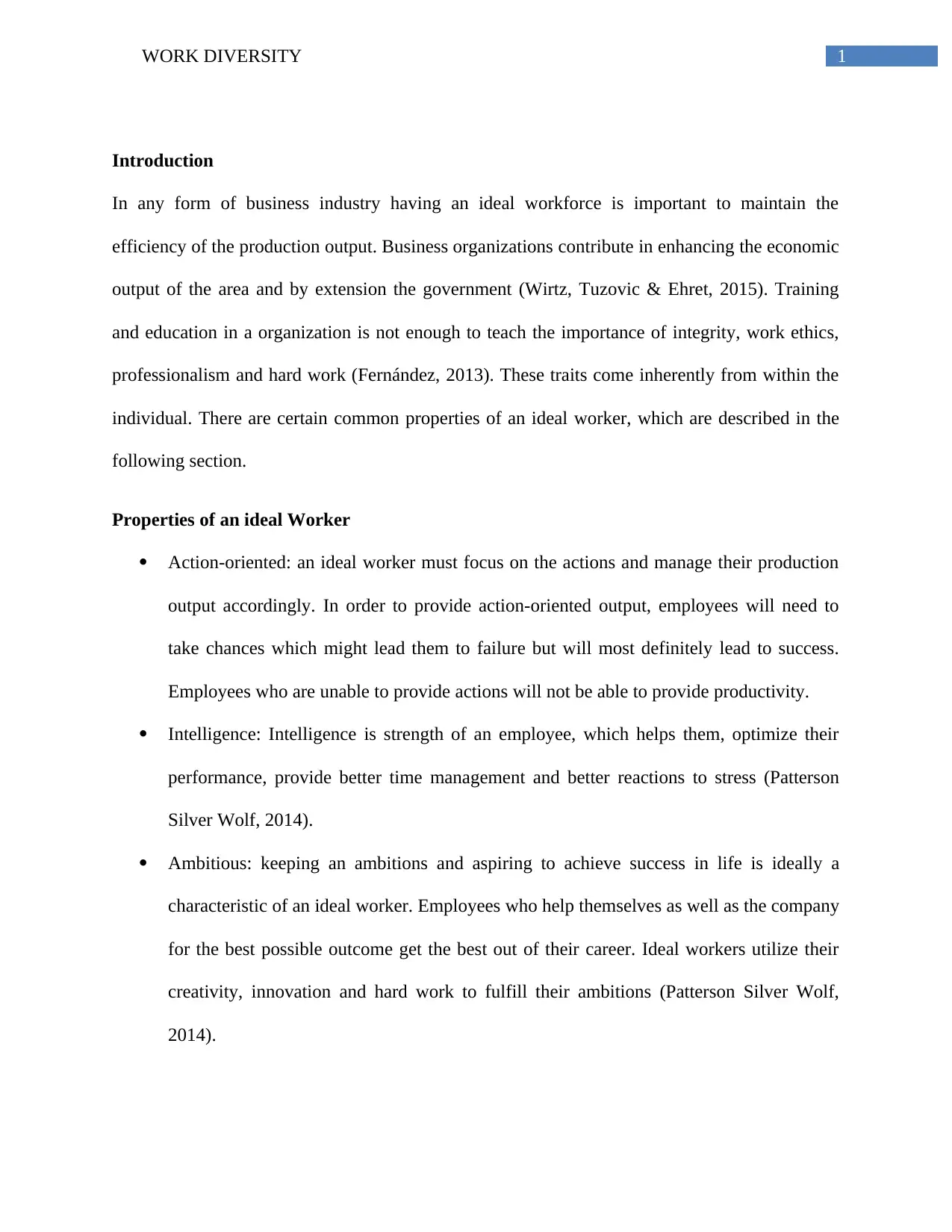
1WORK DIVERSITY
Introduction
In any form of business industry having an ideal workforce is important to maintain the
efficiency of the production output. Business organizations contribute in enhancing the economic
output of the area and by extension the government (Wirtz, Tuzovic & Ehret, 2015). Training
and education in a organization is not enough to teach the importance of integrity, work ethics,
professionalism and hard work (Fernández, 2013). These traits come inherently from within the
individual. There are certain common properties of an ideal worker, which are described in the
following section.
Properties of an ideal Worker
Action-oriented: an ideal worker must focus on the actions and manage their production
output accordingly. In order to provide action-oriented output, employees will need to
take chances which might lead them to failure but will most definitely lead to success.
Employees who are unable to provide actions will not be able to provide productivity.
Intelligence: Intelligence is strength of an employee, which helps them, optimize their
performance, provide better time management and better reactions to stress (Patterson
Silver Wolf, 2014).
Ambitious: keeping an ambitions and aspiring to achieve success in life is ideally a
characteristic of an ideal worker. Employees who help themselves as well as the company
for the best possible outcome get the best out of their career. Ideal workers utilize their
creativity, innovation and hard work to fulfill their ambitions (Patterson Silver Wolf,
2014).
Introduction
In any form of business industry having an ideal workforce is important to maintain the
efficiency of the production output. Business organizations contribute in enhancing the economic
output of the area and by extension the government (Wirtz, Tuzovic & Ehret, 2015). Training
and education in a organization is not enough to teach the importance of integrity, work ethics,
professionalism and hard work (Fernández, 2013). These traits come inherently from within the
individual. There are certain common properties of an ideal worker, which are described in the
following section.
Properties of an ideal Worker
Action-oriented: an ideal worker must focus on the actions and manage their production
output accordingly. In order to provide action-oriented output, employees will need to
take chances which might lead them to failure but will most definitely lead to success.
Employees who are unable to provide actions will not be able to provide productivity.
Intelligence: Intelligence is strength of an employee, which helps them, optimize their
performance, provide better time management and better reactions to stress (Patterson
Silver Wolf, 2014).
Ambitious: keeping an ambitions and aspiring to achieve success in life is ideally a
characteristic of an ideal worker. Employees who help themselves as well as the company
for the best possible outcome get the best out of their career. Ideal workers utilize their
creativity, innovation and hard work to fulfill their ambitions (Patterson Silver Wolf,
2014).
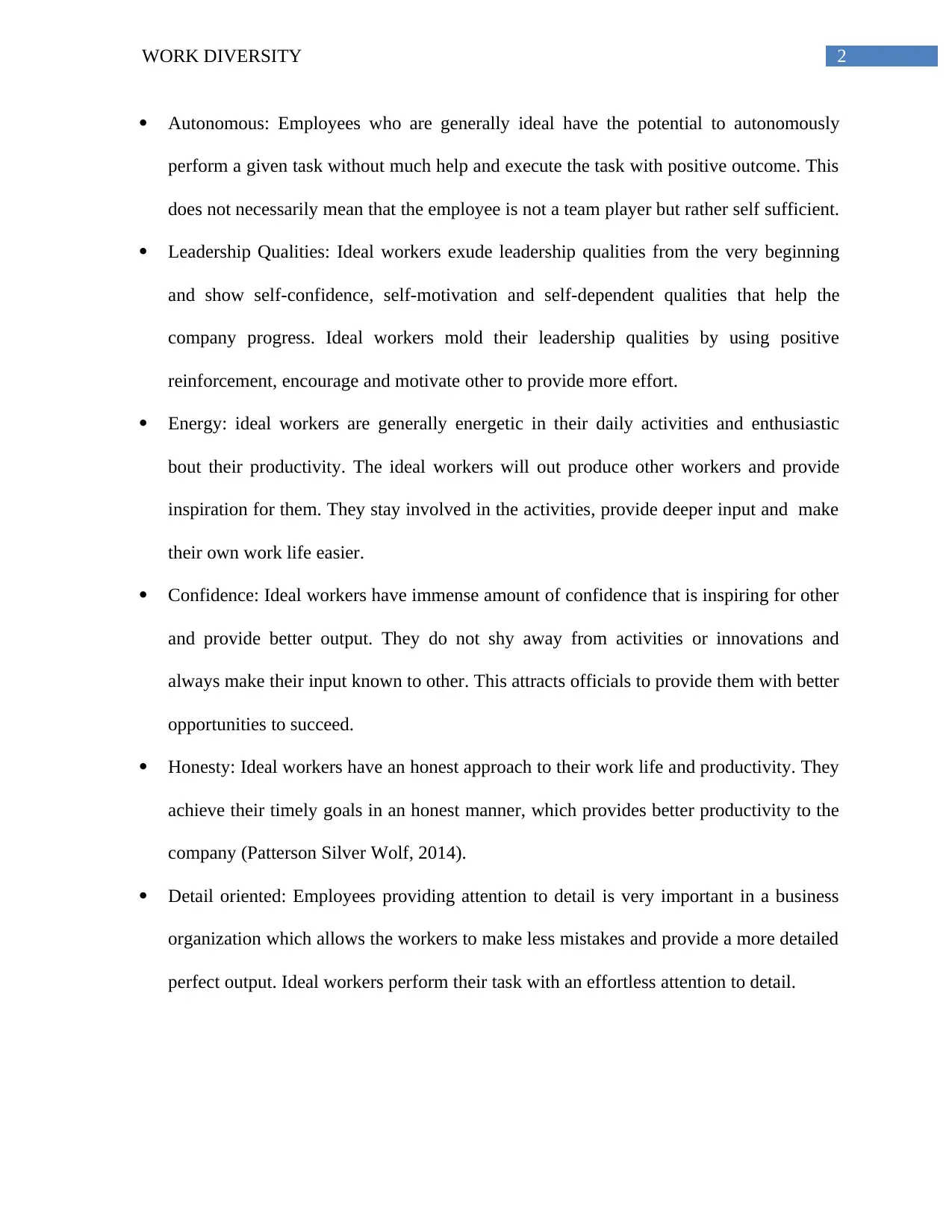
2WORK DIVERSITY
Autonomous: Employees who are generally ideal have the potential to autonomously
perform a given task without much help and execute the task with positive outcome. This
does not necessarily mean that the employee is not a team player but rather self sufficient.
Leadership Qualities: Ideal workers exude leadership qualities from the very beginning
and show self-confidence, self-motivation and self-dependent qualities that help the
company progress. Ideal workers mold their leadership qualities by using positive
reinforcement, encourage and motivate other to provide more effort.
Energy: ideal workers are generally energetic in their daily activities and enthusiastic
bout their productivity. The ideal workers will out produce other workers and provide
inspiration for them. They stay involved in the activities, provide deeper input and make
their own work life easier.
Confidence: Ideal workers have immense amount of confidence that is inspiring for other
and provide better output. They do not shy away from activities or innovations and
always make their input known to other. This attracts officials to provide them with better
opportunities to succeed.
Honesty: Ideal workers have an honest approach to their work life and productivity. They
achieve their timely goals in an honest manner, which provides better productivity to the
company (Patterson Silver Wolf, 2014).
Detail oriented: Employees providing attention to detail is very important in a business
organization which allows the workers to make less mistakes and provide a more detailed
perfect output. Ideal workers perform their task with an effortless attention to detail.
Autonomous: Employees who are generally ideal have the potential to autonomously
perform a given task without much help and execute the task with positive outcome. This
does not necessarily mean that the employee is not a team player but rather self sufficient.
Leadership Qualities: Ideal workers exude leadership qualities from the very beginning
and show self-confidence, self-motivation and self-dependent qualities that help the
company progress. Ideal workers mold their leadership qualities by using positive
reinforcement, encourage and motivate other to provide more effort.
Energy: ideal workers are generally energetic in their daily activities and enthusiastic
bout their productivity. The ideal workers will out produce other workers and provide
inspiration for them. They stay involved in the activities, provide deeper input and make
their own work life easier.
Confidence: Ideal workers have immense amount of confidence that is inspiring for other
and provide better output. They do not shy away from activities or innovations and
always make their input known to other. This attracts officials to provide them with better
opportunities to succeed.
Honesty: Ideal workers have an honest approach to their work life and productivity. They
achieve their timely goals in an honest manner, which provides better productivity to the
company (Patterson Silver Wolf, 2014).
Detail oriented: Employees providing attention to detail is very important in a business
organization which allows the workers to make less mistakes and provide a more detailed
perfect output. Ideal workers perform their task with an effortless attention to detail.
⊘ This is a preview!⊘
Do you want full access?
Subscribe today to unlock all pages.

Trusted by 1+ million students worldwide
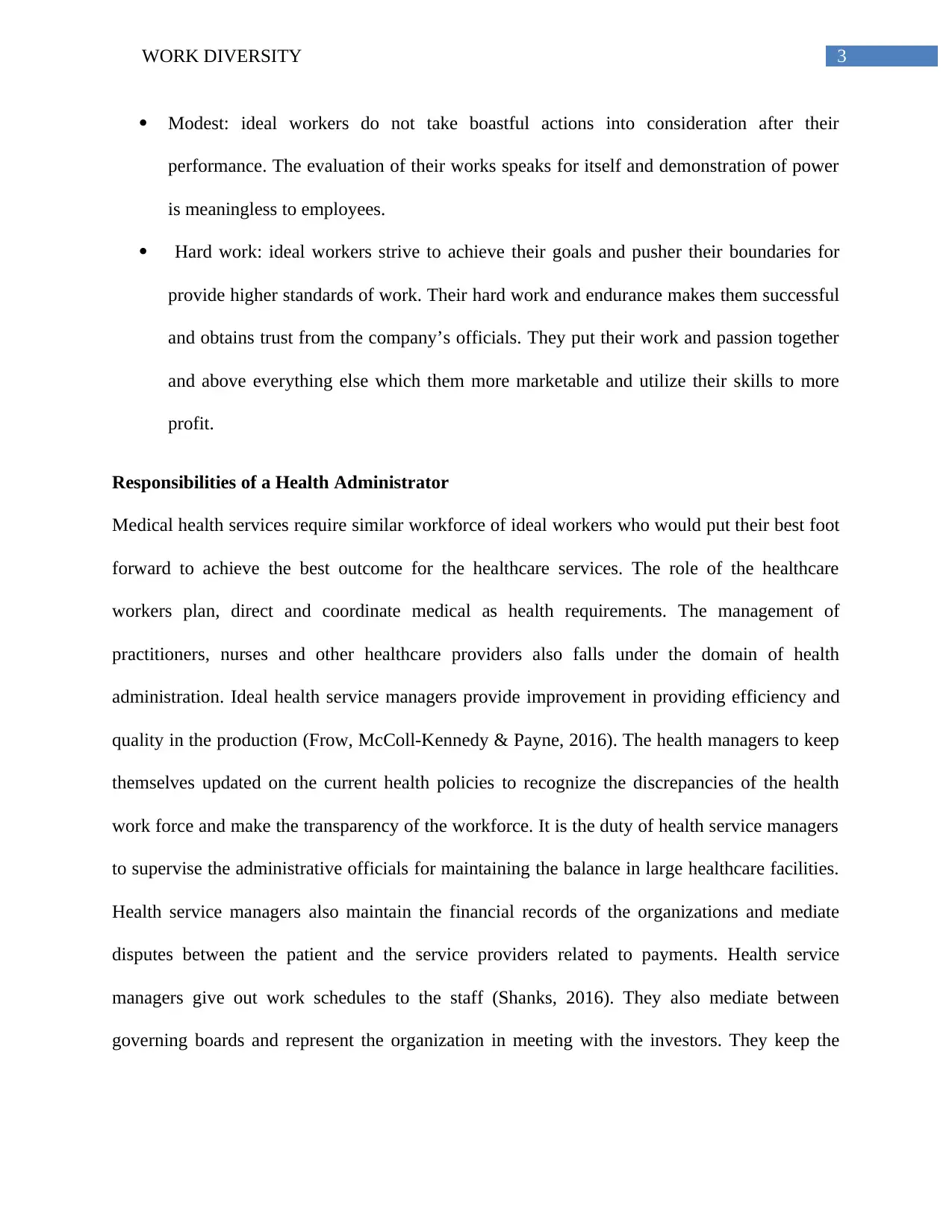
3WORK DIVERSITY
Modest: ideal workers do not take boastful actions into consideration after their
performance. The evaluation of their works speaks for itself and demonstration of power
is meaningless to employees.
Hard work: ideal workers strive to achieve their goals and pusher their boundaries for
provide higher standards of work. Their hard work and endurance makes them successful
and obtains trust from the company’s officials. They put their work and passion together
and above everything else which them more marketable and utilize their skills to more
profit.
Responsibilities of a Health Administrator
Medical health services require similar workforce of ideal workers who would put their best foot
forward to achieve the best outcome for the healthcare services. The role of the healthcare
workers plan, direct and coordinate medical as health requirements. The management of
practitioners, nurses and other healthcare providers also falls under the domain of health
administration. Ideal health service managers provide improvement in providing efficiency and
quality in the production (Frow, McColl-Kennedy & Payne, 2016). The health managers to keep
themselves updated on the current health policies to recognize the discrepancies of the health
work force and make the transparency of the workforce. It is the duty of health service managers
to supervise the administrative officials for maintaining the balance in large healthcare facilities.
Health service managers also maintain the financial records of the organizations and mediate
disputes between the patient and the service providers related to payments. Health service
managers give out work schedules to the staff (Shanks, 2016). They also mediate between
governing boards and represent the organization in meeting with the investors. They keep the
Modest: ideal workers do not take boastful actions into consideration after their
performance. The evaluation of their works speaks for itself and demonstration of power
is meaningless to employees.
Hard work: ideal workers strive to achieve their goals and pusher their boundaries for
provide higher standards of work. Their hard work and endurance makes them successful
and obtains trust from the company’s officials. They put their work and passion together
and above everything else which them more marketable and utilize their skills to more
profit.
Responsibilities of a Health Administrator
Medical health services require similar workforce of ideal workers who would put their best foot
forward to achieve the best outcome for the healthcare services. The role of the healthcare
workers plan, direct and coordinate medical as health requirements. The management of
practitioners, nurses and other healthcare providers also falls under the domain of health
administration. Ideal health service managers provide improvement in providing efficiency and
quality in the production (Frow, McColl-Kennedy & Payne, 2016). The health managers to keep
themselves updated on the current health policies to recognize the discrepancies of the health
work force and make the transparency of the workforce. It is the duty of health service managers
to supervise the administrative officials for maintaining the balance in large healthcare facilities.
Health service managers also maintain the financial records of the organizations and mediate
disputes between the patient and the service providers related to payments. Health service
managers give out work schedules to the staff (Shanks, 2016). They also mediate between
governing boards and represent the organization in meeting with the investors. They keep the
Paraphrase This Document
Need a fresh take? Get an instant paraphrase of this document with our AI Paraphraser
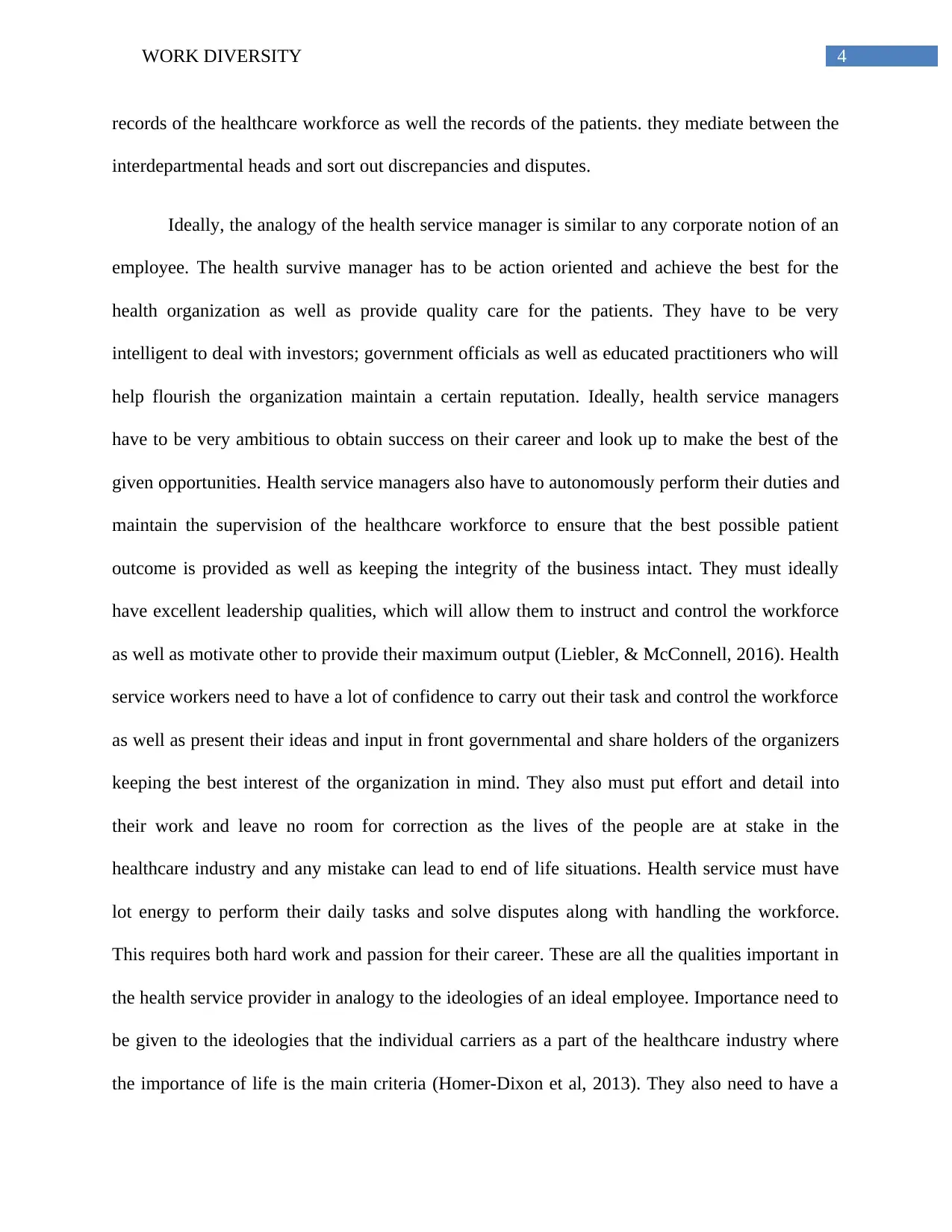
4WORK DIVERSITY
records of the healthcare workforce as well the records of the patients. they mediate between the
interdepartmental heads and sort out discrepancies and disputes.
Ideally, the analogy of the health service manager is similar to any corporate notion of an
employee. The health survive manager has to be action oriented and achieve the best for the
health organization as well as provide quality care for the patients. They have to be very
intelligent to deal with investors; government officials as well as educated practitioners who will
help flourish the organization maintain a certain reputation. Ideally, health service managers
have to be very ambitious to obtain success on their career and look up to make the best of the
given opportunities. Health service managers also have to autonomously perform their duties and
maintain the supervision of the healthcare workforce to ensure that the best possible patient
outcome is provided as well as keeping the integrity of the business intact. They must ideally
have excellent leadership qualities, which will allow them to instruct and control the workforce
as well as motivate other to provide their maximum output (Liebler, & McConnell, 2016). Health
service workers need to have a lot of confidence to carry out their task and control the workforce
as well as present their ideas and input in front governmental and share holders of the organizers
keeping the best interest of the organization in mind. They also must put effort and detail into
their work and leave no room for correction as the lives of the people are at stake in the
healthcare industry and any mistake can lead to end of life situations. Health service must have
lot energy to perform their daily tasks and solve disputes along with handling the workforce.
This requires both hard work and passion for their career. These are all the qualities important in
the health service provider in analogy to the ideologies of an ideal employee. Importance need to
be given to the ideologies that the individual carriers as a part of the healthcare industry where
the importance of life is the main criteria (Homer-Dixon et al, 2013). They also need to have a
records of the healthcare workforce as well the records of the patients. they mediate between the
interdepartmental heads and sort out discrepancies and disputes.
Ideally, the analogy of the health service manager is similar to any corporate notion of an
employee. The health survive manager has to be action oriented and achieve the best for the
health organization as well as provide quality care for the patients. They have to be very
intelligent to deal with investors; government officials as well as educated practitioners who will
help flourish the organization maintain a certain reputation. Ideally, health service managers
have to be very ambitious to obtain success on their career and look up to make the best of the
given opportunities. Health service managers also have to autonomously perform their duties and
maintain the supervision of the healthcare workforce to ensure that the best possible patient
outcome is provided as well as keeping the integrity of the business intact. They must ideally
have excellent leadership qualities, which will allow them to instruct and control the workforce
as well as motivate other to provide their maximum output (Liebler, & McConnell, 2016). Health
service workers need to have a lot of confidence to carry out their task and control the workforce
as well as present their ideas and input in front governmental and share holders of the organizers
keeping the best interest of the organization in mind. They also must put effort and detail into
their work and leave no room for correction as the lives of the people are at stake in the
healthcare industry and any mistake can lead to end of life situations. Health service must have
lot energy to perform their daily tasks and solve disputes along with handling the workforce.
This requires both hard work and passion for their career. These are all the qualities important in
the health service provider in analogy to the ideologies of an ideal employee. Importance need to
be given to the ideologies that the individual carriers as a part of the healthcare industry where
the importance of life is the main criteria (Homer-Dixon et al, 2013). They also need to have a
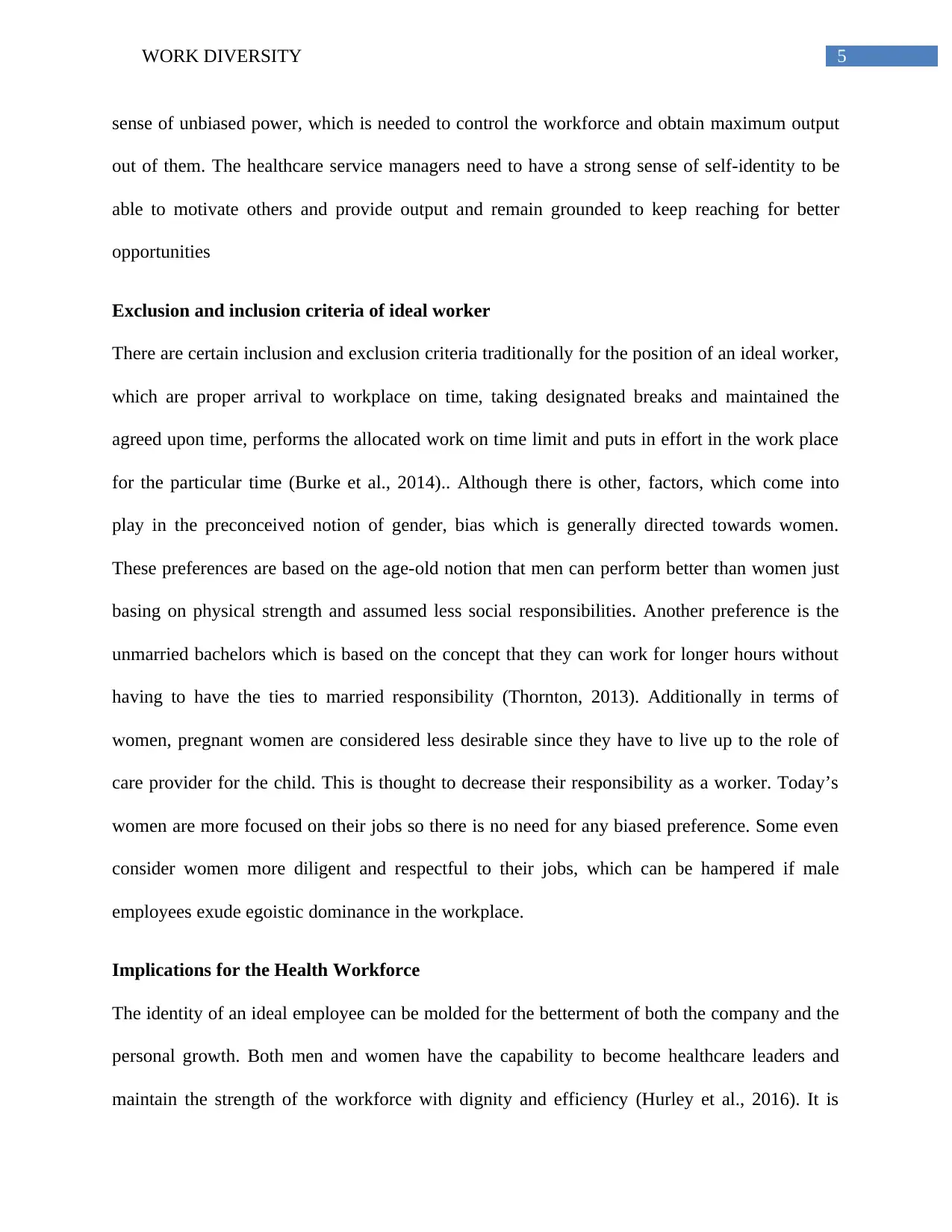
5WORK DIVERSITY
sense of unbiased power, which is needed to control the workforce and obtain maximum output
out of them. The healthcare service managers need to have a strong sense of self-identity to be
able to motivate others and provide output and remain grounded to keep reaching for better
opportunities
Exclusion and inclusion criteria of ideal worker
There are certain inclusion and exclusion criteria traditionally for the position of an ideal worker,
which are proper arrival to workplace on time, taking designated breaks and maintained the
agreed upon time, performs the allocated work on time limit and puts in effort in the work place
for the particular time (Burke et al., 2014).. Although there is other, factors, which come into
play in the preconceived notion of gender, bias which is generally directed towards women.
These preferences are based on the age-old notion that men can perform better than women just
basing on physical strength and assumed less social responsibilities. Another preference is the
unmarried bachelors which is based on the concept that they can work for longer hours without
having to have the ties to married responsibility (Thornton, 2013). Additionally in terms of
women, pregnant women are considered less desirable since they have to live up to the role of
care provider for the child. This is thought to decrease their responsibility as a worker. Today’s
women are more focused on their jobs so there is no need for any biased preference. Some even
consider women more diligent and respectful to their jobs, which can be hampered if male
employees exude egoistic dominance in the workplace.
Implications for the Health Workforce
The identity of an ideal employee can be molded for the betterment of both the company and the
personal growth. Both men and women have the capability to become healthcare leaders and
maintain the strength of the workforce with dignity and efficiency (Hurley et al., 2016). It is
sense of unbiased power, which is needed to control the workforce and obtain maximum output
out of them. The healthcare service managers need to have a strong sense of self-identity to be
able to motivate others and provide output and remain grounded to keep reaching for better
opportunities
Exclusion and inclusion criteria of ideal worker
There are certain inclusion and exclusion criteria traditionally for the position of an ideal worker,
which are proper arrival to workplace on time, taking designated breaks and maintained the
agreed upon time, performs the allocated work on time limit and puts in effort in the work place
for the particular time (Burke et al., 2014).. Although there is other, factors, which come into
play in the preconceived notion of gender, bias which is generally directed towards women.
These preferences are based on the age-old notion that men can perform better than women just
basing on physical strength and assumed less social responsibilities. Another preference is the
unmarried bachelors which is based on the concept that they can work for longer hours without
having to have the ties to married responsibility (Thornton, 2013). Additionally in terms of
women, pregnant women are considered less desirable since they have to live up to the role of
care provider for the child. This is thought to decrease their responsibility as a worker. Today’s
women are more focused on their jobs so there is no need for any biased preference. Some even
consider women more diligent and respectful to their jobs, which can be hampered if male
employees exude egoistic dominance in the workplace.
Implications for the Health Workforce
The identity of an ideal employee can be molded for the betterment of both the company and the
personal growth. Both men and women have the capability to become healthcare leaders and
maintain the strength of the workforce with dignity and efficiency (Hurley et al., 2016). It is
⊘ This is a preview!⊘
Do you want full access?
Subscribe today to unlock all pages.

Trusted by 1+ million students worldwide
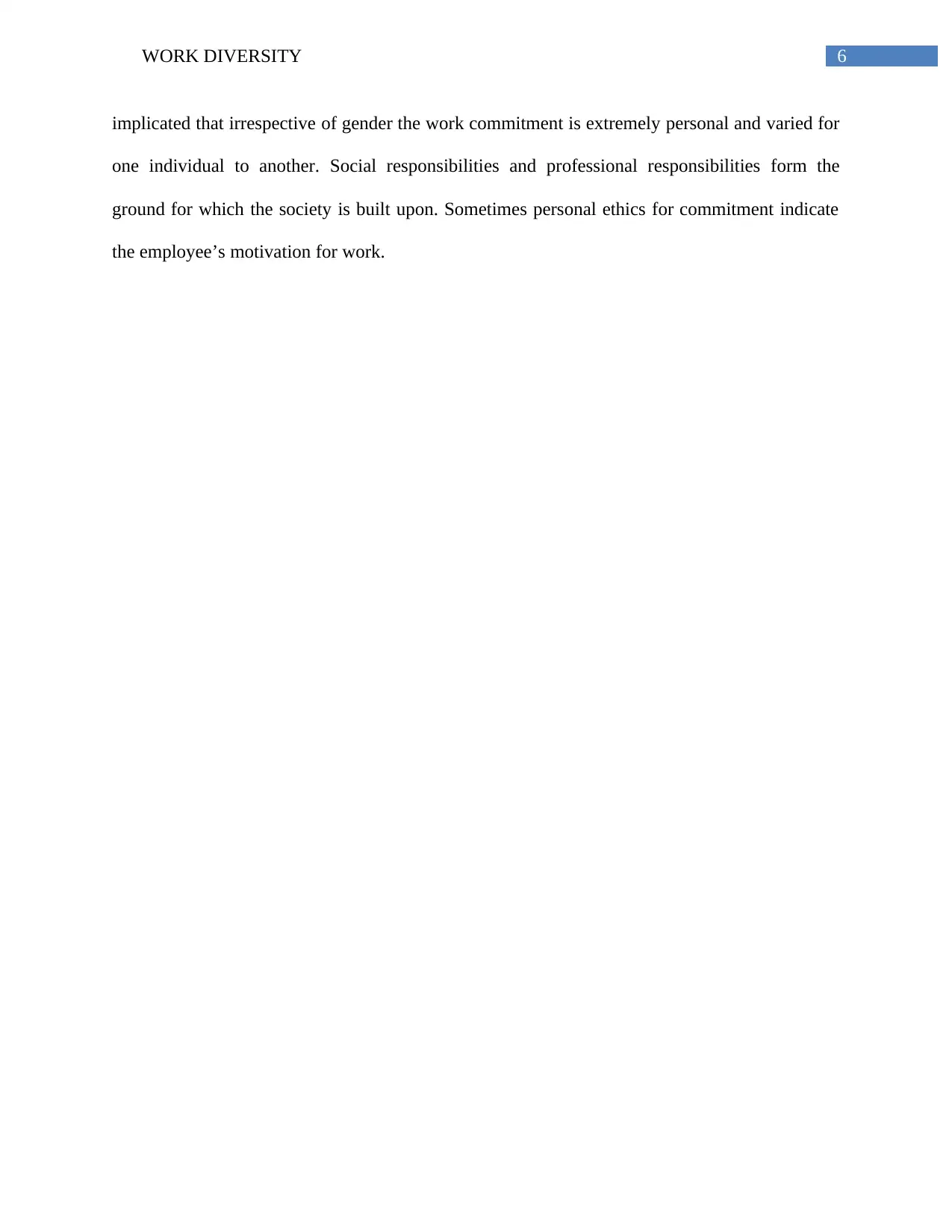
6WORK DIVERSITY
implicated that irrespective of gender the work commitment is extremely personal and varied for
one individual to another. Social responsibilities and professional responsibilities form the
ground for which the society is built upon. Sometimes personal ethics for commitment indicate
the employee’s motivation for work.
implicated that irrespective of gender the work commitment is extremely personal and varied for
one individual to another. Social responsibilities and professional responsibilities form the
ground for which the society is built upon. Sometimes personal ethics for commitment indicate
the employee’s motivation for work.
Paraphrase This Document
Need a fresh take? Get an instant paraphrase of this document with our AI Paraphraser
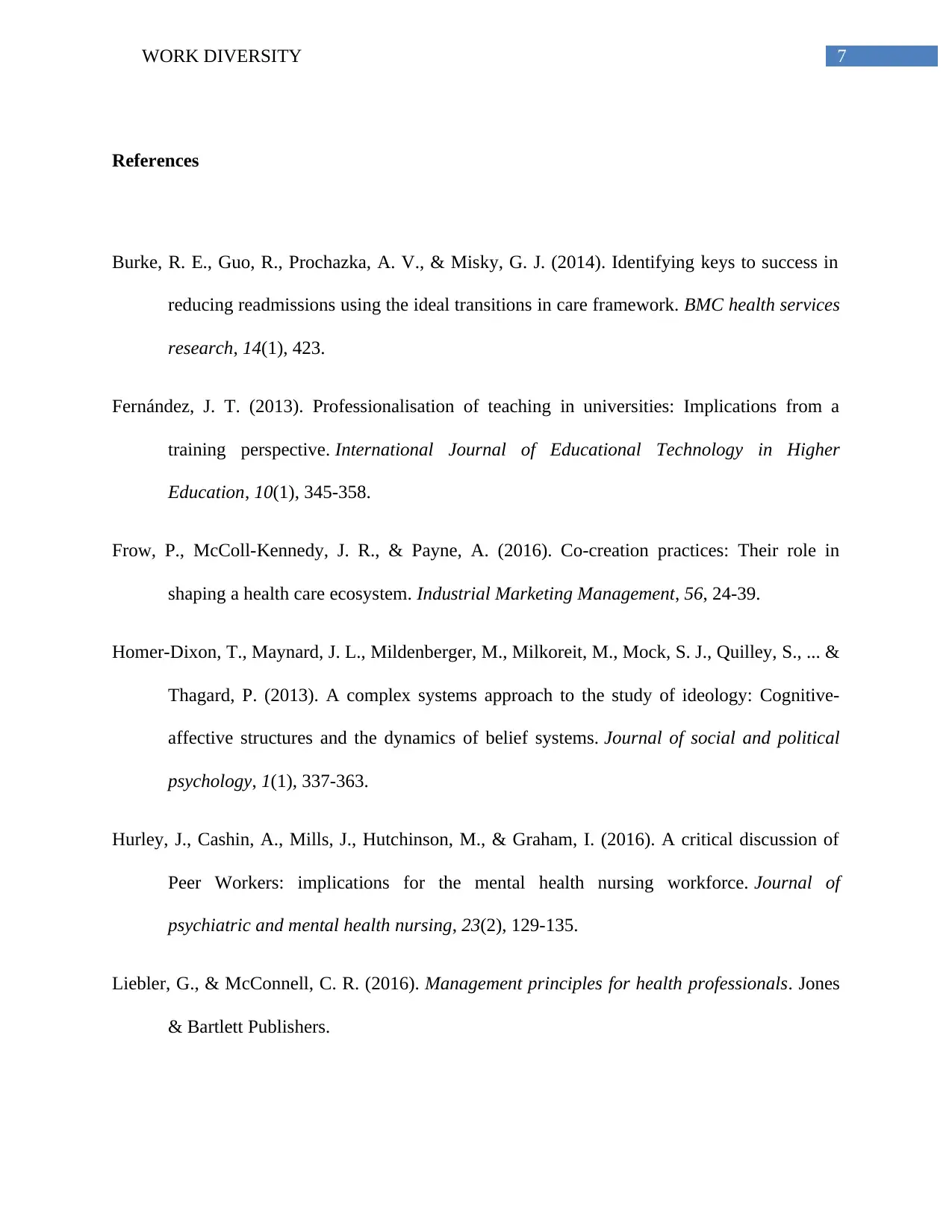
7WORK DIVERSITY
References
Burke, R. E., Guo, R., Prochazka, A. V., & Misky, G. J. (2014). Identifying keys to success in
reducing readmissions using the ideal transitions in care framework. BMC health services
research, 14(1), 423.
Fernández, J. T. (2013). Professionalisation of teaching in universities: Implications from a
training perspective. International Journal of Educational Technology in Higher
Education, 10(1), 345-358.
Frow, P., McColl-Kennedy, J. R., & Payne, A. (2016). Co-creation practices: Their role in
shaping a health care ecosystem. Industrial Marketing Management, 56, 24-39.
Homer-Dixon, T., Maynard, J. L., Mildenberger, M., Milkoreit, M., Mock, S. J., Quilley, S., ... &
Thagard, P. (2013). A complex systems approach to the study of ideology: Cognitive-
affective structures and the dynamics of belief systems. Journal of social and political
psychology, 1(1), 337-363.
Hurley, J., Cashin, A., Mills, J., Hutchinson, M., & Graham, I. (2016). A critical discussion of
Peer Workers: implications for the mental health nursing workforce. Journal of
psychiatric and mental health nursing, 23(2), 129-135.
Liebler, G., & McConnell, C. R. (2016). Management principles for health professionals. Jones
& Bartlett Publishers.
References
Burke, R. E., Guo, R., Prochazka, A. V., & Misky, G. J. (2014). Identifying keys to success in
reducing readmissions using the ideal transitions in care framework. BMC health services
research, 14(1), 423.
Fernández, J. T. (2013). Professionalisation of teaching in universities: Implications from a
training perspective. International Journal of Educational Technology in Higher
Education, 10(1), 345-358.
Frow, P., McColl-Kennedy, J. R., & Payne, A. (2016). Co-creation practices: Their role in
shaping a health care ecosystem. Industrial Marketing Management, 56, 24-39.
Homer-Dixon, T., Maynard, J. L., Mildenberger, M., Milkoreit, M., Mock, S. J., Quilley, S., ... &
Thagard, P. (2013). A complex systems approach to the study of ideology: Cognitive-
affective structures and the dynamics of belief systems. Journal of social and political
psychology, 1(1), 337-363.
Hurley, J., Cashin, A., Mills, J., Hutchinson, M., & Graham, I. (2016). A critical discussion of
Peer Workers: implications for the mental health nursing workforce. Journal of
psychiatric and mental health nursing, 23(2), 129-135.
Liebler, G., & McConnell, C. R. (2016). Management principles for health professionals. Jones
& Bartlett Publishers.
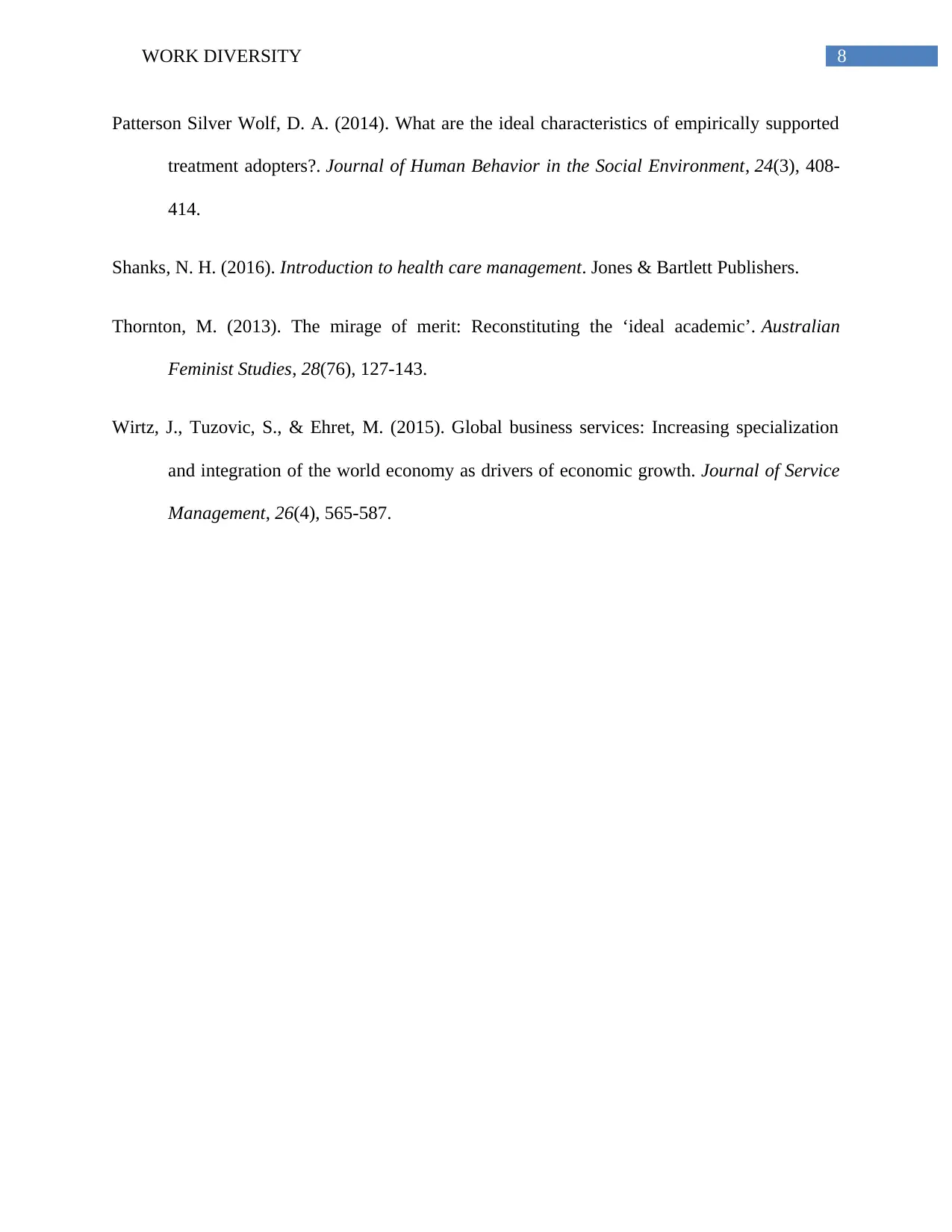
8WORK DIVERSITY
Patterson Silver Wolf, D. A. (2014). What are the ideal characteristics of empirically supported
treatment adopters?. Journal of Human Behavior in the Social Environment, 24(3), 408-
414.
Shanks, N. H. (2016). Introduction to health care management. Jones & Bartlett Publishers.
Thornton, M. (2013). The mirage of merit: Reconstituting the ‘ideal academic’. Australian
Feminist Studies, 28(76), 127-143.
Wirtz, J., Tuzovic, S., & Ehret, M. (2015). Global business services: Increasing specialization
and integration of the world economy as drivers of economic growth. Journal of Service
Management, 26(4), 565-587.
Patterson Silver Wolf, D. A. (2014). What are the ideal characteristics of empirically supported
treatment adopters?. Journal of Human Behavior in the Social Environment, 24(3), 408-
414.
Shanks, N. H. (2016). Introduction to health care management. Jones & Bartlett Publishers.
Thornton, M. (2013). The mirage of merit: Reconstituting the ‘ideal academic’. Australian
Feminist Studies, 28(76), 127-143.
Wirtz, J., Tuzovic, S., & Ehret, M. (2015). Global business services: Increasing specialization
and integration of the world economy as drivers of economic growth. Journal of Service
Management, 26(4), 565-587.
⊘ This is a preview!⊘
Do you want full access?
Subscribe today to unlock all pages.

Trusted by 1+ million students worldwide
1 out of 9
Related Documents
Your All-in-One AI-Powered Toolkit for Academic Success.
+13062052269
info@desklib.com
Available 24*7 on WhatsApp / Email
![[object Object]](/_next/static/media/star-bottom.7253800d.svg)
Unlock your academic potential
Copyright © 2020–2025 A2Z Services. All Rights Reserved. Developed and managed by ZUCOL.



